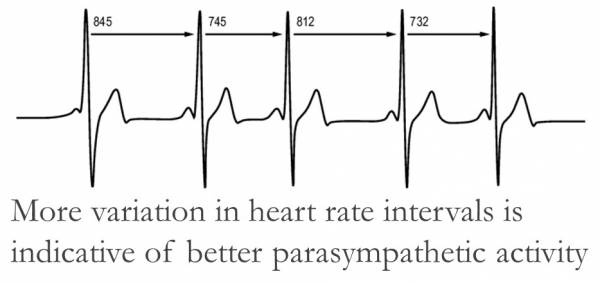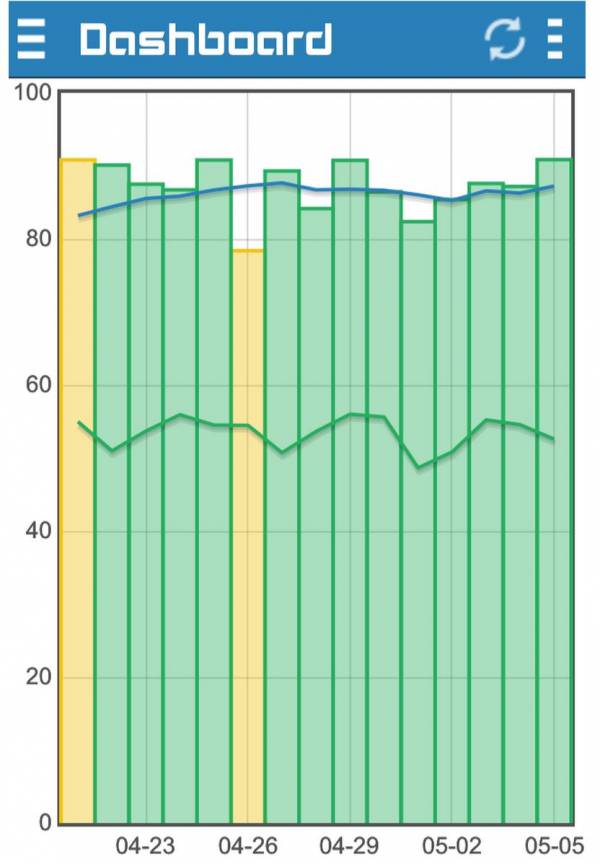Heart rate variability is an indicator of how well the parasympathetic nervous system functions. It provides athletes with a powerful measure of both their recovery and their ability to function well in an upcoming workout.
READ MORE: Heart Rate Variability a Good Intensity Measure
The Sympathetic and Parasympathetic Nervous Systems
The autonomic nervous system is made up of two components: the sympathetic and parasympathetic systems:
- The sympathetic nervous system is similar to a gas pedal in a car. When we press the gas pedal, more gas is pumped into the engine, which allows us to go faster or apply more torque. Similarly, when our sympathetic system ramps up, our heart pumps out more blood to allow for more nutrients to feed the muscles.
- The parasympathetic system can be likened to the brakes in a car. We want a responsive braking system. We don’t want to have jerky brakes that lock up or brakes that don’t engage enough.
As we are building our perfect machine, we want to have a good acceleration system, as well as an optimal system to slow ourselves down. If we think about taking fast curves in our car, we need sensitive and responsive brakes to allow for the fastest possible driving of the curves. The parasympathetic system is our brakes.
The Vagus Nerve Controls the Systems
The vagus nerve innervates many different organs. One branch of our vagus nerve (our brakes) slows down heart rate. As we inhale, that branch of our vagus nerve is inhibited (so our brakes are not responsive), which allows our sympathetic system (our gas) to run free. As we exhale, our vagus nerve inhibitory action returns and our heart rate slows down.8 This mechanism is probably one of the reasons for the benefits of meditative breathing.3,7
What Is Vagal Tone and Heart Rate Variability?
Vagal tone is a general term for the responsiveness of our braking system. There are multiple ways to measure it. One of the most precise ways is to measure respiration and heart rate. We can then calculate the effect of the vagal nerve on heart rate (called respiratory sinus arrhythmia).
“Athletes can now measure heart rate variability outside the lab by measuring heart rate and having an app do relatively complex calculations.”
This calculation is pretty complicated as it is taking different waveforms and transforming them to a measure of vagal power. The problem with this method is that we need to take into account respiration. In our lab, we can connect people for an hour-long study with around seven sensors to get an accurate of picture of heart rate and respiration. In the real world, this application is not practical. Luckily, we can skip measuring respiration and still get a pretty accurate account of vagal tone with just a heart rate monitor.
The change in heart rate, or heart rate variability, gives us a simple way to measure how well our parasympathetic system works. More variation in our heart rate is indicative of greater parasympathetic activity. Athletes can now measure heart rate variability outside the lab by measuring heart rate and having an app do relatively complex calculations. This measurement is inexpensive and accurate – if you follow some simple rules.

Equipment for Measuring Heart Rate
A look through the Google Play store or the App Store will reveal hundreds of apps that have something to do with heart rate variability. At Pulse Beat Fit, we have two reviews of complete systems, BioForce HRV and iThlete. Both of these systems have free apps, but you must purchase the heart monitoring system through their websites. The nice part of these apps is that you get the complete package and both provide information tailored for athletes.
“I suggest you measure right after waking. It only takes about two minutes and it provides a great excuse to stay in bed a little longer.”
Another option is to purchase (or use an existing) heart rate monitor band and a compatible app. I use My HRV beta as my app (sorry, only for Android) and a compatible Polar heart rate monitor (total cost around $50). I am also testing another potentially good heart rate variability app, Elite HRV, which is available for both Android and Apple products.

Elite HRV Dashboard
Important Issues in Monitoring Heart Rate Variability
The time of day, substances ingested, movement, and mood are all important variables in measuring heart rate variability. I suggest you measure right after waking. It only takes about two minutes and it provides a great excuse to stay in bed a little longer.
Here is my routine:
- After waking, put on the heart rate monitor band.
- Start the app, lay back, and let it run for about two minutes (two minutes or more gives an adequate amount of data for the algorithms to process; shorter times may not be as accurate).
It will take a few days before the numbers will become meaningful. I would take notes on your workouts to see the correlations between your numbers and how you feel. The numbers are related to you and are not useful unless you can compare it to your previous data (furthermore, different apps use different algorithms, so the numbers between apps will be different, as well). Some apps provide guidance on your ability to perform. I would use those as rough rules of thumb, but rely mostly on your numbers relative to previous numbers.
RELATED: Heart Rate Monitoring: An Effective Test for Overtraining

Why You Should Care About Heart Rate Variability
Many different health outcomes are associated with poor heart rate variability including diabetes, obesity, hypertension, and other cardiovascular diseases.2,10 For athletes, there seems to be a reciprocal relationship that exercise (anerobic and aerobic) increases heart rate variability and that heart rate variability is a good indicator of exercise performance.1,4,6,9 In a recent study with judo athletes, monitoring heart variability was useful for determining athletes’ stress and recovery from earlier workouts.5 So, as far as indicators of overtraining, the most important factor for you to consider might be heart rate variability.
RELATED: Eat, Drink, and Be Healthy: How to Fuel Your Performance
Summary
Heart rate variability is a relatively simple measure that athletes can use to test how well they are recovering. Recent mobile technology lets us monitor our heart rate variability in our homes and relatively inexpensively. As recovery is a vital component of our continued progress, it make sense to measure it. The better we eat, sleep, and reduce stress, then the better our heart rate variability, and hence our recovery.
References:
1. Aubert, AE., et al. 2003. “Heart Rate Variability in Athletes.” Sports Medicine 33 (12): 889–919.
2. Chambers, AS., et al. 2007. “Cardiac Vagal Control, Emotion, Psychopathology, and Health.” Biological Psychology 74 (2): 113–15. doi:10.1016/j.biopsycho.2006.09.004.
3. Epel, E. et al. 2009. “Can Meditation Slow Rate of Cellular Aging? Cognitive Stress, Mindfulness, and Telomeres.” Annals of the New York Academy of Sciences 1172 (1): 34–53. doi:10.1111/j.1749-6632.2009.04414.x.
4. Furlan, R., et al. 1993. “Early and Late Effects of Exercise and Athletic Training on Neural Mechanisms Controlling Heart Rate.” Cardiovascular Research 27 (3): 482–88.
5. Morales, J, et al. 2013. “The Use of Heart Rate Variability in Monitoring Stress and Recovery in Judo Athletes.” Journal of Strength and Conditioning Research, November, 1. doi:10.1519/JSC.0000000000000328.
6. Mourot, L., et al. 2004. “Decrease in Heart Rate Variability with Overtraining: Assessment by the Poincaré Plot Analysis.” Clinical Physiology and Functional Imaging 24 (1): 10–18.
7. Nesvold, A. “Increased Heart Rate Variability during Nondirective Meditation.” European Journal of Cardiovascular Prevention & Rehabilitation, June. doi:10.1177/1741826711414625.
8. Porges, SW. 2007. “A Phylogenetic Journey through the Vague and Ambiguous Xth Cranial Nerve: A Commentary on Contemporary Heart Rate Variability Research.” Biological Psychology 74 (2): 301–7. doi:10.1016/j.biopsycho.2006.08.007.
9. Sacknoff, DM.1994. “Effect of Athletic Training on Heart Rate Variability.” American Heart Journal 127 (5): 1275–78.
10. Stauss, Harald M. 2003. “Heart Rate Variability.” American Journal of Physiology – Regulatory, Integrative and Comparative Physiology 285 (5): R927–31. doi:10.1152/ajpregu.00452.2003.
Photos 1 & 4 courtesy of Shutterstock.
Photo 3 courtesy of Elite HRV.






